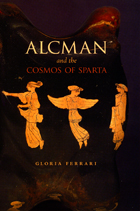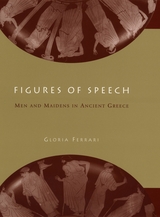2 books about Ferrari, Gloria

Alcman and the Cosmos of Sparta
Gloria Ferrari
University of Chicago Press, 2008
The Partheneion, or “maiden song,” composed in the seventh century BCE by the SpartanpoetAlcman, is the earliest substantial example of a choral lyric. A provocative reinterpretation of the Partheneion and its broader context, Alcman and the Cosmos of Sparta excavates the poem’s invocations of widespread and long-lived cosmological ideas that cast the universe as perfectly harmonious and invested its workings with an ethical dimension.
Moving far beyond standard literary interpretations, Gloria Ferrari uncovers this astral symbolism by approaching the poem from several angles to brilliantly reconstruct the web of ancient drama, music, religion, painting, and material culture in which it is enmeshed. She shows, for example, that by stringing together images of horses, stars, and birds, the poem evokes classical antiquity’s beloved dance of the constellations. Instrumental in shaping the structure of the lyric, this dance symbolizes the cosmic order reflected in the order of the state, which the chorus would have enacted in a ritual performance of the song.
With broad implications for archaeology, art history, and ancient science, Ferrari’s bold new analysis dramatically deepens our understanding of Greek poetry and the rich culture of archaic Sparta.
[more]

Figures of Speech
Men and Maidens in Ancient Greece
Gloria Ferrari
University of Chicago Press, 2002
Over the past two hundred years, thousands of ancient Greek vases have been unearthed. Yet these artifacts remain a challenge: what did the images depicted on these vases actually mean to ancient Greek viewers? In this long-awaited book, Gloria Ferrari uses Athenian vases, literary evidence, and other works of art from the Archaic and Classical periods (520-400 B.C.) to investigate what these items can tell us about the ancient Greeks—specifically, their notions of gender.
Ferrari begins by developing a theoretical perspective on visual representation, arguing that artistic images give us access to how their subjects were imagined rather than to the way they really were. For instance, Ferrari's examinations of the many representations of women working wool reveal that these images constitute powerful metaphors—metaphors, she argues, which both reflect and construct Greek conceptions of the ideal woman and her ideal behavior.
From this perspective, Ferrari studies a number of icons representing blameless femininity and ideal masculinity to reevaluate the rites of passage by which girls are made ready for marriage and boys become men. Representations of the nude male body in Archaic statues known as kouroi, for example, symbolize manhood itself and shed new light on the much-discussed institution of paiderastia. And, in Ferrari's hands, imagery equating maidens with arable land and buried treasure provides a fresh view of Greek ideas of matrimony.
Innovative, thought-provoking, and insightful throughout, Figures of Speech is a powerful demonstration of how the study of visual images as well as texts can reshape our understanding of ancient Greek culture.
Ferrari begins by developing a theoretical perspective on visual representation, arguing that artistic images give us access to how their subjects were imagined rather than to the way they really were. For instance, Ferrari's examinations of the many representations of women working wool reveal that these images constitute powerful metaphors—metaphors, she argues, which both reflect and construct Greek conceptions of the ideal woman and her ideal behavior.
From this perspective, Ferrari studies a number of icons representing blameless femininity and ideal masculinity to reevaluate the rites of passage by which girls are made ready for marriage and boys become men. Representations of the nude male body in Archaic statues known as kouroi, for example, symbolize manhood itself and shed new light on the much-discussed institution of paiderastia. And, in Ferrari's hands, imagery equating maidens with arable land and buried treasure provides a fresh view of Greek ideas of matrimony.
Innovative, thought-provoking, and insightful throughout, Figures of Speech is a powerful demonstration of how the study of visual images as well as texts can reshape our understanding of ancient Greek culture.
[more]
READERS
Browse our collection.
PUBLISHERS
See BiblioVault's publisher services.
STUDENT SERVICES
Files for college accessibility offices.
UChicago Accessibility Resources
home | accessibility | search | about | contact us
BiblioVault ® 2001 - 2024
The University of Chicago Press









